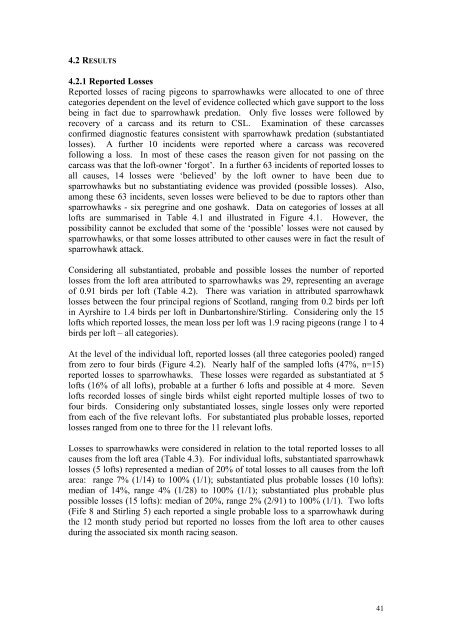RACING PIGEONS â IMPACT OF RAPTOR PREDATION
RACING PIGEONS â IMPACT OF RAPTOR PREDATION
RACING PIGEONS â IMPACT OF RAPTOR PREDATION
You also want an ePaper? Increase the reach of your titles
YUMPU automatically turns print PDFs into web optimized ePapers that Google loves.
4.2 RESULTS<br />
4.2.1 Reported Losses<br />
Reported losses of racing pigeons to sparrowhawks were allocated to one of three<br />
categories dependent on the level of evidence collected which gave support to the loss<br />
being in fact due to sparrowhawk predation. Only five losses were followed by<br />
recovery of a carcass and its return to CSL. Examination of these carcasses<br />
confirmed diagnostic features consistent with sparrowhawk predation (substantiated<br />
losses). A further 10 incidents were reported where a carcass was recovered<br />
following a loss. In most of these cases the reason given for not passing on the<br />
carcass was that the loft-owner ‘forgot’. In a further 63 incidents of reported losses to<br />
all causes, 14 losses were ‘believed’ by the loft owner to have been due to<br />
sparrowhawks but no substantiating evidence was provided (possible losses). Also,<br />
among these 63 incidents, seven losses were believed to be due to raptors other than<br />
sparrowhawks - six peregrine and one goshawk. Data on categories of losses at all<br />
lofts are summarised in Table 4.1 and illustrated in Figure 4.1. However, the<br />
possibility cannot be excluded that some of the ‘possible’ losses were not caused by<br />
sparrowhawks, or that some losses attributed to other causes were in fact the result of<br />
sparrowhawk attack.<br />
Considering all substantiated, probable and possible losses the number of reported<br />
losses from the loft area attributed to sparrowhawks was 29, representing an average<br />
of 0.91 birds per loft (Table 4.2). There was variation in attributed sparrowhawk<br />
losses between the four principal regions of Scotland, ranging from 0.2 birds per loft<br />
in Ayrshire to 1.4 birds per loft in Dunbartonshire/Stirling. Considering only the 15<br />
lofts which reported losses, the mean loss per loft was 1.9 racing pigeons (range 1 to 4<br />
birds per loft – all categories).<br />
At the level of the individual loft, reported losses (all three categories pooled) ranged<br />
from zero to four birds (Figure 4.2). Nearly half of the sampled lofts (47%, n=15)<br />
reported losses to sparrowhawks. These losses were regarded as substantiated at 5<br />
lofts (16% of all lofts), probable at a further 6 lofts and possible at 4 more. Seven<br />
lofts recorded losses of single birds whilst eight reported multiple losses of two to<br />
four birds. Considering only substantiated losses, single losses only were reported<br />
from each of the five relevant lofts. For substantiated plus probable losses, reported<br />
losses ranged from one to three for the 11 relevant lofts.<br />
Losses to sparrowhawks were considered in relation to the total reported losses to all<br />
causes from the loft area (Table 4.3). For individual lofts, substantiated sparrowhawk<br />
losses (5 lofts) represented a median of 20% of total losses to all causes from the loft<br />
area: range 7% (1/14) to 100% (1/1); substantiated plus probable losses (10 lofts):<br />
median of 14%, range 4% (1/28) to 100% (1/1); substantiated plus probable plus<br />
possible losses (15 lofts): median of 20%, range 2% (2/91) to 100% (1/1). Two lofts<br />
(Fife 8 and Stirling 5) each reported a single probable loss to a sparrowhawk during<br />
the 12 month study period but reported no losses from the loft area to other causes<br />
during the associated six month racing season.<br />
41
















